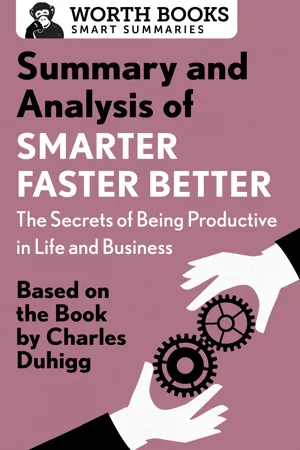Summary
Introduction
Charles Duhigg’s interest in the science of productivity began as he was finishing his previous book, The Power of Habit. Overwhelmed with work and personal responsibilities, Duhigg sought the advice of Atul Gawande, a surgeon, New Yorker staff writer, bestselling author, Harvard professor, and adviser to the World Health Organization. Duhigg wanted to know how Gawande managed to accomplish so much. When he learned that the preternaturally busy doctor still found time to attend rock concerts with his kids and go on mini-vacations with his wife, Duhigg became convinced that some people know how to be more productive than others. He set out to discover their secrets, and soon noticed that the airline pilots, military generals, cognitive scientists, and others he interviewed were mentioning a handful of key concepts over and over. The eight most important ideas for improving productivity make up the eight chapters of Smarter Faster Better.
1. Motivation
In the late 1980s, French neurologist Michel Habib began studying cases in which people suddenly lost interest and energy for no apparent reason. In one such case, a middle-aged man was stung by a wasp and lost all desire to interact with his family and business colleagues. The neurologist discovered that the apathetic individuals had burst blood vessels inside their striatum. This part of the brain relays commands from the prefrontal cortex, where decisions are made, to the basal ganglia, where movement and emotions materialize. This is where one’s motivation lives.
Further research has revealed that the anticipation of making a choice leads to increased activity in the striatum. However, when a choice is made on a person’s behalf, his or her striatum remains essentially silent. The neurological relationship between motivation and choice indicates that people are more motivated when they believe they are in control.
Psychologists differentiate between an internal and an external “locus of control.” People with a strong internal locus believe they control their own destiny, while those with an external locus believe their lives are influenced by forces outside of their control. In an experiment that reveals the motivational power of activating an internal locus of control, a group of students were given a set of hard puzzles to solve. Each student was told they did a very good job. However, half of the students were complimented for working hard, while the other half was complimented for being smart. When a second set of puzzles was given out, the students who believed hard work was key to their success worked longer, did better, and had more fun with the new puzzles than the students who believed intelligence—an innate capacity largely beyond their control—was more important.
Fortunately, internal locus of control is a learned skill that can be developed through practice. The US Marine Corps redesigned its basic training program to force recruits to take control of their choices and develop a “bias toward action.” They are deliberately assigned tasks without instructions, which requires them to move beyond following orders and figure things out for themselves. They are taught to help one another through miserable experiences by asking “why” questions—if they can link a difficult chore to a choice they care about, it’s easier to self-motivate.
Studies have shown that people with a strong internal locus of control stay married longer, make more money, and have more friends. Seniors who rebel against the rigid schedules and set menus of their nursing homes live longer than those who simply follow the rules. Making choices—even small ones—feels good, and the more meaningful our decisions, the greater the rewards and the easier it is to self-motivate.
Need to Know: In order to find the motivation to start an unpleasant or tedious task, it helps to make a choice that allows you to exert control. Pick which section of the assignment—conclusion, bibliography, etc.—you’ll write first, or decide in which room a meeting will take place.
2. Teams
In an effort to find out how to create the perfect team, Google’s People Analytics group, part of its human resources division, launched a program called Project Aristotle. Researchers reviewed academic literature on group dynamics, spent more than 150 hours interviewing employees, and gathered as much data as possible, but were unable to find patterns revealing how a team’s composition correlated to its success. Only when they shifted focus from “who” made up a team to “how” it behaved did useful patterns emerge.
“Group norms” are the traditions and unwritten rules that dictate how a team functions. Is it okay to interrupt each other? Is gossiping allowed, or does the group prefer to get straight to business? Over time, all groups develop guidelines about appropriate behavior; these norms play a key role in determining how it feels to be a member of the group. According to Google’s Project Aristotle and a Harvard study of two Boston hospitals, the positive group norms consistently associated with productivity share the common trait of creating “psychological safety.”
Psychological safety is “‘the shared belief, held by members of a team, that the group is a safe place for taking risks.’” A close look at the history of the seminal TV series Saturday Night Live reveals the importance of fostering a sense of togetherness while also encouraging people to take chances. In the show’s first season, cast members and writers, many of whom had limited professional experience and were personal friends with creator Lorne Michaels, sometimes got in bitter disagreements. Cliques formed and reformed, and everyone competed aggressively for airtime and Michaels’s affection. Still, the first season was a big success, and SNL has now become one of the longest-running programs in television history. Much of the credit goes to...
